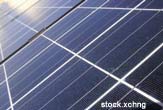The Real Value of Solar Power for Your Home

Environmentalists have long advocated living off the grid—using the power of the sun without relying on traditional public utilities. Solar power channels the sun’s energy and produces electricity through photovoltaic cells and offers a clean alternative to coal-burning electricity that generates greenhouse gases that damage the environment.
Lining your roof with solar panels can be expensive but can save you cash in the long run.
In addition to getting free energy from the sun, many states have rebates and tax incentives that can offset some of the cost of home solar equipment. Moreover, a “green” house may be attractive to homebuyers and boost your home’s resale price. And in the end, you just can’t put a price on the future of our planet.
The sunny side of power
While many people lack the means for putting up solar panels on their roofs, smaller-scale solutions exist that also reap the economical and environmental benefits of solar power. Nowadays, solar-powered products span a wide spectrum, such as solar-powered lights and power chargers for cell phones, digital audio players, and more.
Besides helping save money and the environment, solar-power products bring convenience, simplicity and flexibility to your life. Easy to use gadgets like solar yard lights are set-it-and-forget-it products that you simply take it out of the box, stick into the ground, and never worry about again. Most products are easy to install, requiring no power cables or wiring; installations can in many cases be completed in minutes without professional assistance.
The lack of wires for power also adds convenience and safety. Now you no longer need to run wires through your garden to the solar-powered yard lights or look for a power socket while camping or at the beach.
Sign up for the Live Science daily newsletter now
Get the world’s most fascinating discoveries delivered straight to your inbox.
Solar cells require no moving parts, so they run silent, require little overall maintenance and thus last longer.
The downside of solar
Even as technology advancements have jumped by leaps and bounds, we still do not possess the ability to control the sun.
Solar power depends entirely on the whim of the sun, and thus it’s major downside: inconsistency. Whether environmental, like clouds or smog, or man-made as with obstructing buildings or tinted windows, obstacles that block out the sun will render any solar-powered device powerless. So if you live under the canopies of the Amazon rainforest or in the long winter nights of Iceland where you get only 4 hours of daylight a day, solar power will not likely be an option.
Under the best conditions, a typical solar powered device, like a yard light, stays powered for 8 to 10 hours with about 10 to 12 hours of charging in the sun.
Living the solar-powered life
Whether you're a do-it-yourselfer or a couch potato, solar-powered devices offer a myriad of options.
For those that have the interest, technical know-how and most importantly, money, relining your entire roof with solar panels will pay off for yourself and the environment in the long run.
However, for those just wanting to get their feet wet with solar power, many devices require little to no effort to setup. Many outdoor lighting devices are simple and inexpensive; choose from solar-powered yard lights to solar-powered floodlights. You can also keep your home and loved ones safe and secure with a solar-powered security camera that is not only easy to set up but requires only the power of the sun to operate.
Many other affordable options can be found online or in stores that virtually anyone can install and use.









